Tour around the cathedral (starting at the bishop's gate clockwise)
Ölberg relief (around 1440) - photo not yet available
Man of pain (similar to the toothache god) - photo not yet available

Gravestone of doctor Mathias Cornax (?)
Mathias Cornax, *1508 in Olomouc, Moravia, (Olomouc, Czech Republic), +29 November 1564 in Vienna, doctor, pharmacist. From 1545 he was professor of the medical faculty (four times dean, 1552 rector) and on 10 November 1549 he led the first operative abdominal opening (laparotomy; removal of an extrauterine pregnancy = caesarean section).
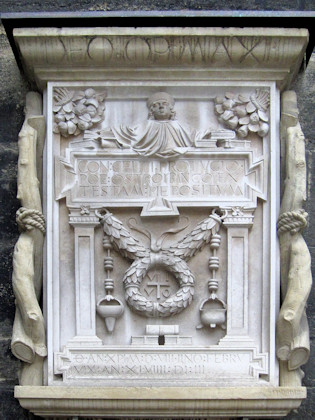
Renaissance epitaph for the humanist Konrad Celtes (copy of the original inside the cathedral)
Celtes (also Celtis) was the first German poet to be crowned poet laureate (laurel crowned poet) by Emperor Friedrich III in Nuremberg on 1.5.1487. He died in Vienna in 1508 as a teacher of poetry.

Totenkapelle (1752), in which Wolfgang Amadeus Mozart was consecrated on 6 December 1791 (commemorative plaque) with portrait relief, dedicated by the Wiener Schubertbund, 1931); Capistran pulpit (c. 1430) with baroque essay ("Der Heilige mit Fahne über verstürzen Türken") after a design by François Roëttiers (executed by Johann Josef Rösler, 1738) in memory of the sermons of Johannes von Capistrans.

Niche of the destroyed Gutstocker epitaph (1523; fragments in the cathedral and diocesan museum)

Poor soul niche with copy of the "Zahnwehherrgott" (1826) and three Passion reliefs (presumably at the beginning of the 15th century).

six late-Gothic passion frescoes (around 1500)

Lackner epitaph with Olive Mountain motif (sandstone relief with late Gothic frame) and gravestones of the Lackner family of citizens of the town

Sträub-Epitaph (Renaissance grave relief, surrounded by seven relief medallions of Mary's pain, c. 1520)
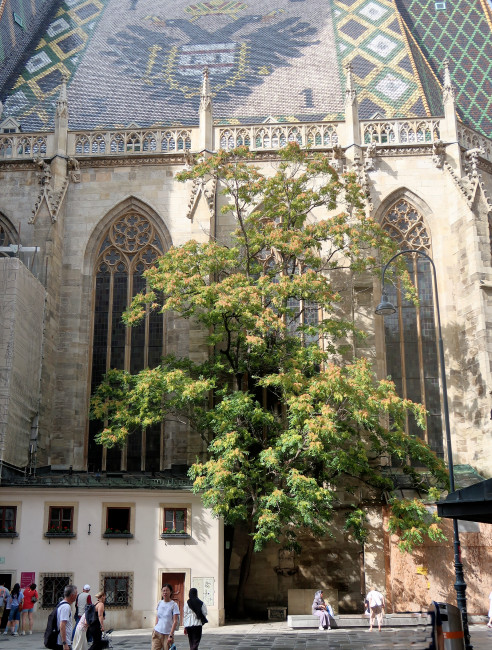
The city's most prominent tree of heaven (Ailanthus) grows by the staircase to the south tower. In winter, the cocoons of the Alianthus moth hang from its branches. The large, brown moth hatches in summer and impresses tourists at Stephansplatz with a wingspan of up to 15 centimetres.

Epitaph for the cathedral master builder Friedrich Schmidt (east side) - here in the picture - and Leopold Ernst (west side of the south tower) with portrait busts by Carl Kundmann (1894)
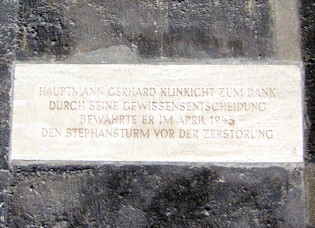
Between these two epitaphs a commemorative plaque was placed in memory of Captain Gerhard Klinkicht, the rescuer of St. Stephen's Cathedral in 1945.

Epitaph for Larenz Flaischer (Lorenz Fleischer +1541)
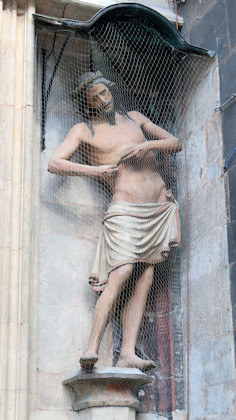
Schmerzensmann (Man of Sorrows)
On the eastern buttress adjoining the porch of the Singertor there is a larger-than-life sculpture of Christ pointing the wounds at the front. This man of pain, expressive in facial expressions and gestures, is probably a late work from around 1435 by the "Michael master". According to another source, it was made around 1372.

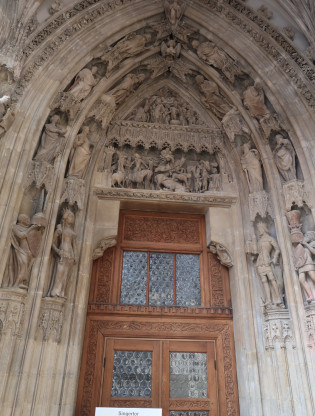
The Singertor, the south-west entrance to the cathedral, owes its name to the singers who used to enter the church from this side. The magnificent portal with the tympanum from around 1360, which depicts the life and conversion of St Paul in dramatic images, has housed a concert box office since 2024. The polygonal porch that we see today was built around 1440 during the reign of Emperor Frederick III, presumably to protect the portal's rich programme of figures.
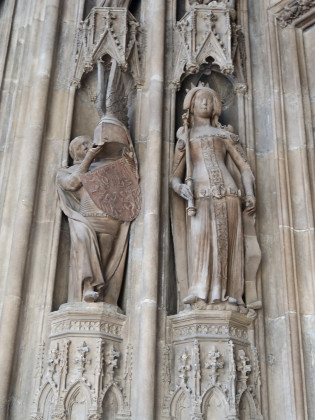
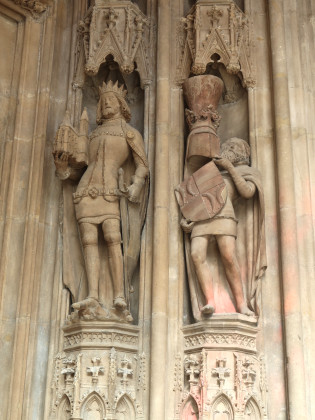
The portal is framed by various figures. Bottom right: Rudolf IV, the founder, and on the left his wife Katharina, each accompanied by coat of arms bearers.
The Neithart grave is located right next to the Singertor.
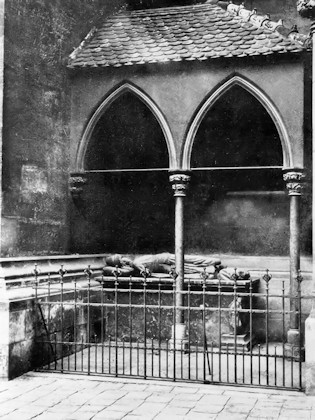
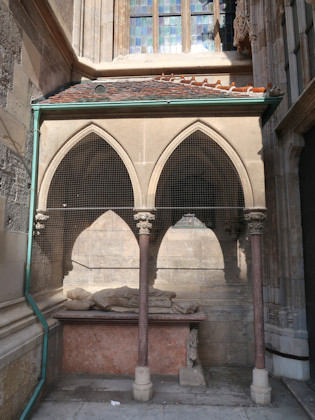
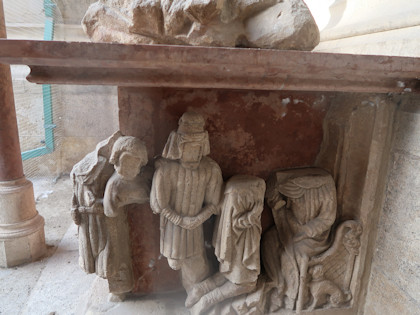
At the corner of the Eligius Chapel, next to the porch of the Singertor, you can see the tomb of Otto the Merry, Nithard Otto Fuchs of the Merry Council (court jesters). This art monument, which was erected soon after the death of the minnesinger Neidhard or Nithard, about 1334, from sandstone by an unknown master, is unfortunately severely mutilated. On the lid of the high grave the picture of Nithard in life size is shown. He is wearing aristocratic clothes and is girded with a sword. Next to him there used to be a fox, which indicates his name as well as his coat of arms. A lion lies at his feet. On the side walls in former times the infamous brawl with which Neithart allegedly acquired the name of the farmer's enemy was depicted in half-work. From this basic relief only the moment remains how Neithart brings the Duke the news that he has found the first violet of spring.
(B/W - photo from the year 1926)
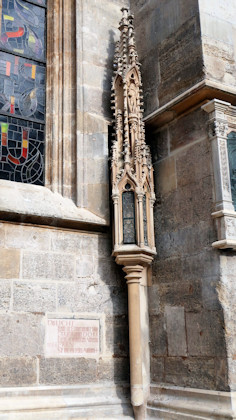
Gothic death lamp (copy)
On the outer wall of the Eligius Chapel there is a late Gothic light column on a buttress. Originally a similar one stood freely on the cemetery, which was around the cathedral, as a death light (see legend: The Revenge of the Dead)
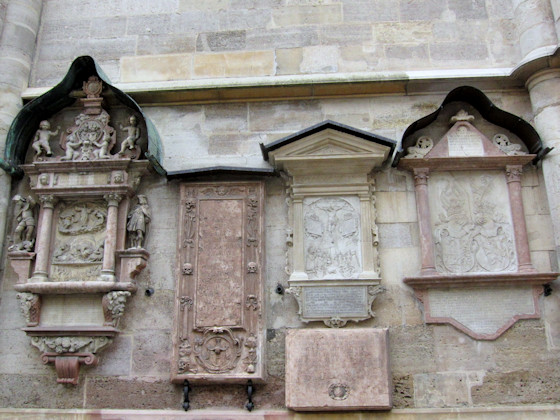
various epitaphs on the western front
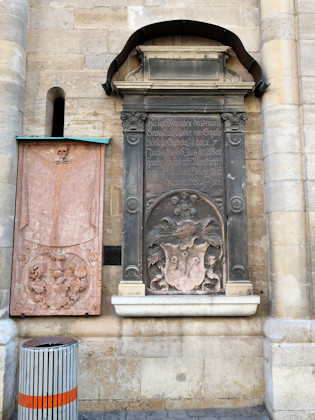
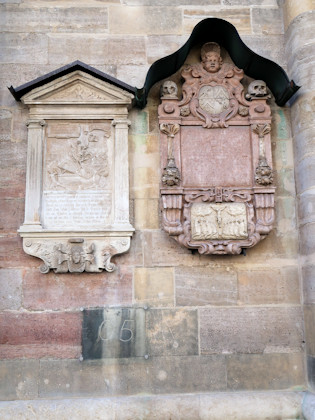
At the end of the Second World War, the sign "O5" was carved to the right of the giant gate. The state of Austria no longer existed. A resistance group fighting for an independent Austria and the separation from National Socialist Germany marked the first two letters of the word "Austria", i.e. 05: because by 5 one meant the fifth letter in the alphabet (the E).

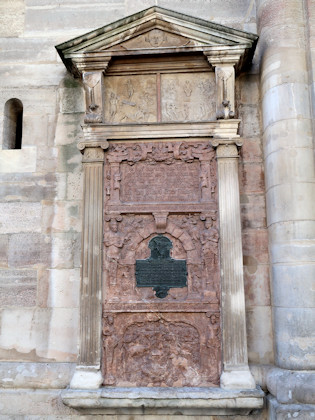
Epitaph left of the giant gate